Table 3.
Head, neck, mouth, and lip movements.
a. Rotational Head or Whole Body Shaking
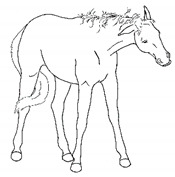
|
Rapid, rhythmic rotation of the whole body or just the head and neck along the long axis. This is similar to shaking in response to cutaneous irritation around the head, neck, or body, e.g., insects. Rotational head or whole body shaking is often associated with bearing weight on an affected limb or another behavior, such as lifting or kicking a limb. May occur during prolonged periods of unrelieved discomfort, often during episodes of fidgeting. Video S36 https://doi.org/10.5281/zenodo.4540550 (accessed on 18 February 2021) |
b. Frustration Head Tossing
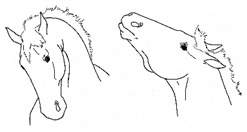
|
Quick rotational toss of the head, similar to a head threat. Video S37 https://doi.org/10.5281/zenodo.4540554 (accessed on 18 February 2021) |
c. Head Bobbing
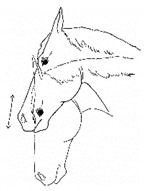
|
Repetitive nodding of head and neck. Not usually as rhythmic as with a stereotypy. Often appears to reflect frustration with persistent discomfort, particularly when the horse seems unable to find a comfortable posture. Video S38 https://doi.org/10.5281/zenodo.4540559 (accessed on 18 February 2021) |
d. Nose Tossing/Flipping
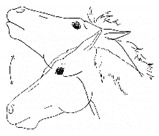
|
Flicking upward extension of the head and neck. Not usually rhythmic, as with a stereotypy. Often appears to reflect frustration with persistent discomfort, particularly when the horse seems unable to find a comfortable posture. Video S39 https://doi.org/10.5281/zenodo.4540563 (accessed on 18 February 2021) |
e. Abbreviated Weaving
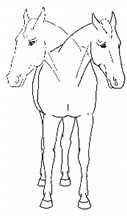
|
Rhythmic side-to-side swaying of the head and neck. Typically does not include animated weight shifting and alternate flexing, lifting, and/or lateral movement of forelimbs, as is common with the stereotypy form of weaving. Video S40 https://doi.org/10.5281/zenodo.4540565 (accessed on 18 February 2021) |
f. Sympathetic Surge Resolution Signs: Extending Tongue, Licking, Chewing, Itching
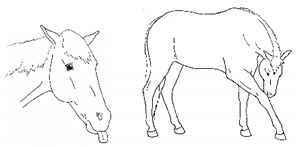
|
Cluster of autonomic responses following an acute sympathetic surge, including salivation (leading to chewing movements, swallowing, tongue extensions) and/or autogrooming (typically rubbing face against forelimb). Video S41 https://doi.org/10.5281/zenodo.4541367 (accessed on 18 February 2021) |
g. Frequent Yawning Bouts
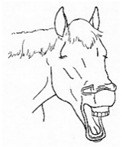
|
Frequent bouts of yawning, often with a greater number of yawns per bout than is characteristic (greater than 3 to 5). Often associated with changes in sympathetic tone, so may occur intermittently with lip licking, chewing, tongue extensions characteristic of sympathetic surge resolution signs. Video S42 https://doi.org/10.5281/zenodo.4541373 (accessed on 18 February 2021) |
h. Spontaneous Flehmen Response
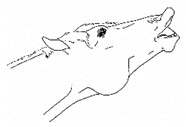
|
Lifting of the head with curling of the upper lip, drawing nasal fluids into the vomeronasal organ. Flehmen is a normal response within the context of sniffing pungent fluids, typically in a social olfactory context, but with discomfort, flehmen may occur out of that context. Video S43 https://doi.org/10.5281/zenodo.4541379 (accessed on 18 February 2021) |
i. Lip Quivering/Wincing
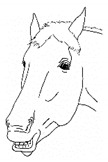
|
Involuntary movements (twitching) of the lips and nares, often with relaxation (drooping) of the lower lip. Video S44 https://doi.org/10.5281/zenodo.4541385 (accessed on 18 February 2021) |
j. Tilting Head
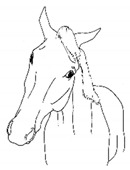
|
Holding or cocking the head to one side, such that the sagittal plane is off vertical. Video S45 https://doi.org/10.5281/zenodo.4541387 (accessed on 18 February 2021) |
